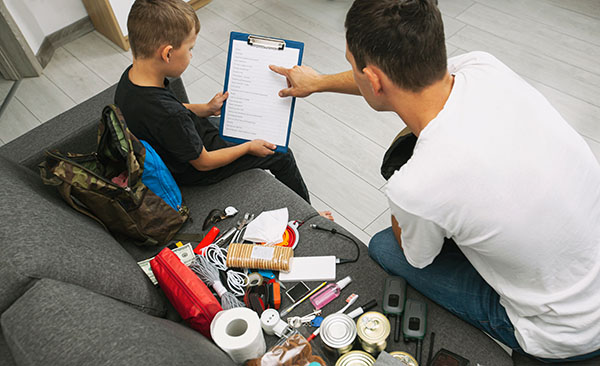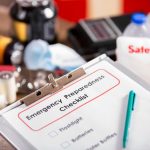
Water, food and more: A detailed emergency preparedness checklist for preppers
Monday, April 21, 2025 by Zoey Sky
http://www.naturalnewstips.com/2025-04-21-tips-detailed-emergency-preparedness-checklist-for-preppers.html

- Store at least three days’ worth of water (one gallon per person per day), but aim for two weeks. Use clean containers, learn to purify water and rotate stored water every six months.
- Focus on calorie-dense staples (rice, beans, pasta), canned goods and comfort foods. Include no-cook options (tuna pouches, crackers) and cooking fats for energy.
- Have flashlights, solar-powered chargers, hand-crank radios and alternative heat sources ready. Keep ice packs to extend fridge cooling.
- Reinforce doors/windows, have evacuation plans with bug-out bags and know offline escape routes. Stay warm with thermal layers and sleeping bags.
- Have backup communication (hand-crank radios, satellite messengers), learn first aid and stock medical supplies (trauma kits, meds). Practice drills for quick evacuations.
Do you know what that nagging feeling is when a storm knocks out the power or the news reports supply chain disruptions? It’s not paranoia, it’s your instinct.
But you don’t need a bunker or a lifetime supply of freeze-dried meals to be ready for emergencies.
What you need is a straightforward, no-nonsense preparedness plan that covers the essentials without turning your home into a doomsday prepper’s stockroom. (h/t to PreppersWill.com)
Being prepared isn’t about fear. Preppers know that it’s about stacking the deck in your favor so you can handle whatever comes your way with confidence.
Below are some tips that will help you check items off your emergency preparedness checklist:
Water: The non-negotiable priority
Remember that you can survive weeks without food but only days without water. Dehydration impairs judgment, weakens the body and accelerates panic.
What you need:
- One gallon of water per person per day – You should have a minimum three-day supply, but setting up a two-week supply is better.
- Multiple purification methods – Stock up on things like tools for boiling, water filters or bleach.
Store water in seven-gallon BPA-free jugs or a WaterBOB that can hold 100 gallons of water in your bathtub if you have advance warning.
Alternatively, you can store more water in clean soda bottles or other clean, non-milk containers.
If you still need more water, your water heater holds up to 40 to 80 gallons. Learn how to drain it in an emergency.
Make sure you rotate your water supply every six months to avoid a stale taste.
Food: More than just canned beans
Hungry people make bad decisions. Your food stash should keep you energized and sane when dealing with emergencies.
Stock up on the “survival food trio.”
What you need:
- Staples – Rice, pasta and beans are calorie-dense and have a long shelf life.
- Nutritional backups – Canned fruits, vegetables and meat. Avoid bulging or damaged cans.
- Comfort foods – Coffee, chocolate and your favorite snacks can help boost morale when things are tough.
Quick no-cook meals for power outages:
- Crackers with peanut butter and honey, perfect for kids who are picky eaters
- Tuna pouches, no can opener needed
- Freeze-dried meals, just add water
Store cooking fat (oil or lard) that boosts calories and makes meals taste better. (Related: Budget-friendly tips to up your prepper game.)
Power: When the grid goes dark
No electricity means no lights, refrigeration or phone charging. Don’t wait until it’s too late.
What you need:
- Flashlights and headlamps – Avoid single-use batteries.
- Portable power bank – Solar-powered is best.
- Hand-crank radio – For monitoring emergency alerts.
- Alternative heat source – Stay warm with battery-powered heated blankets or a kerosene heater (with ventilation).
Keep ice packs in the freezer to help prolong fridge temperatures during outages.
Shelter and warmth: Staying safe indoors (or out)
If bugging in or staying home isn’t safe, you need an evacuation plan for bugging out after SHTF.
Shelter-in-place essentials:
- Sleeping bags and extra blankets – Get extras for those who need more than one.
- Thermal clothing layers – Avoid cotton clothing because it traps moisture.
- Oil-burning hurricane lantern – This kind of lantern provides light and slight heat.
Evacuation plan:
- Prepare bug-out bags for each person. Keep the bags in an easy-to-reach area so you can quickly grab them when SHTF.
- Secure a rendezvous point or a safe meet-up spot if the family gets separated.
- Find offline maps and secure multiple escape routes since your GPS may fail.
Security: Avoiding desperate situations
Disasters can bring out the worst in people. Be smart, not scared.
Basic security measures for fortifying your home:
- Reinforced doors and windows – Use security film on windows and get sturdy locks.
- Motion-sensor lights – Get solar-powered lights that will still work during blackouts.
- Self-defense weapons – If you’re getting a firearm, learn how to use it properly. You can also get pepper spray or a tactical flashlight.
- Subdued security – Don’t advertise your supplies to nosy neighbors.
Know your neighbors. A coordinated community is safer than going it alone.
First aid and medical supplies
Hospitals may be overwhelmed after disaster strikes so you need to learn how to handle injuries at home.
Medical must-haves:
- Hygiene supplies – Stock up on hygiene supplies like bleach, sanitizer and feminine products.
- Medications – You need pain relievers and extra medications for family members with chronic health conditions.
- Trauma kit – The kit should have a tourniquet, hemostatic gauze and chest seals.
Before SHTF, take a “Stop the Bleed” course. Note that knowing first aid is more valuable than just having supplies.
Communication: When cell towers fail
Phones don’t work in true emergencies. Always have backups.
Ways to stay connected:
- Hand-crank or solar radio – You will need a radio to listen to emergency broadcasts.
- GMRS (General Mobile Radio Service)/FRS (Family Radio Service) radios – You will need these for short-range family communication.
- Satellite messenger – A device like a Garmin inReach Mini is best for long-distance SOS.
- Printed contact list – This list must include out-of-state emergency contacts.
Evacuation readiness: The ultimate test
Most people wait too long to leave, so don’t be one of them.
Prepared evacuation measures:
- “Go bag” with cash, IDs, meds and spare keys.
- Your car should always have at least a half-full tank of gas.
- Have several alternate routes mapped out.
Before SHTF, run evacuation drills. Try to improve your time so you can leave in under five minutes.
Preparedness isn’t about extremes, it’s all about small, smart steps. Start with water, food and a communication plan, then build from there.
The goal isn’t to become a survivalist, it’s to sleep well knowing you’re ready for whatever comes.
Visit FoodSupply.news for more tips on how to start building your food stockpile. You can also check out Health Ranger Store and Brighteon Store for more clean food supplies for your prepping needs.
Watch this clip about Organic Mashed Potatoes and why they’re a delicious and nutritious addition to your daily routine and survival stockpile.
This video is from the Health Ranger Store channel on Brighteon.com.
More related stories:
Surviving a power grid attack: How to stay safe in a grid-down scenario.
Prepping 101: Tips to help you start your prepping journey.
Survival basics: How to stay alive when the unexpected happens.
13 Things to add to your to-do list for summer gardening.
Sources include:
Tagged Under: Tags: bug out, emergency food, emergency preparedness, food supply, homesteading, how-to, off grid, preparedness, prepper, Prepper to-do list, prepping, prepping supplies, SHTF, survival, survival gear, survival supplies, tips, to-do list
RECENT ARTICLES


Vacuum sealers: The budget-friendly secret to cutting grocery bills and prepping for emergencies
By Zoey Sky

Preparing for the unexpected: Tips for building an apartment emergency kit
By Zoey Sky

“Wartime Homefront Essential Skills” on BrightU: Safe roadkill harvesting and growing tomatoes like a boss
By Jacob Thomas

Balancing blood sugar starts with FIBER, INOSITOL, and other metabolic-modulating herbal compounds
COPYRIGHT © 2017 NATURAL NEWS TIPS


